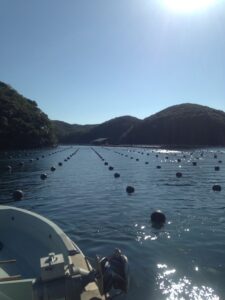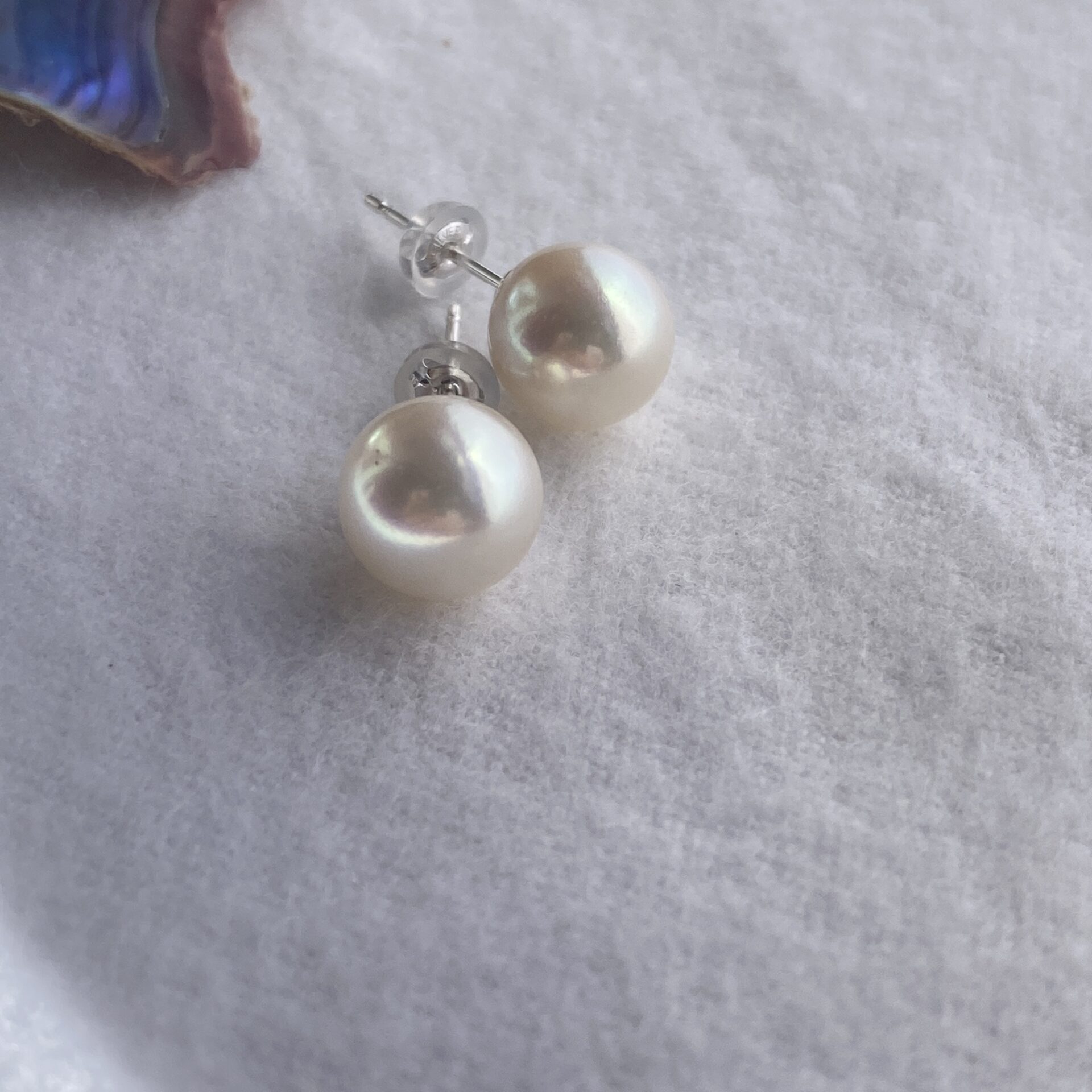

永遠 Towa
$163.64
1 in stock
The pearls were obtained from the great-grandson of Yasuie Tōdō, the inventor of pearl stain removal in 1922 and founder of Takahashi Pearl. More than a century ago, Tōdō invested in pearl farms in Sukumo City, Kōchi Prefecture, where the world’s first round cultured pearls were created. Although a flood in 1920 destroyed those farms, his later invention of stain removal became a cornerstone of modern pearl processing and remains widely used today.
Kept in his family for decades, these pearls are estimated to be at least 60 years old—likely older, perhaps from the period when Sukumo’s pearl farms were still active. While they are not flawless, their meaning lies in their origin and the history they carry.
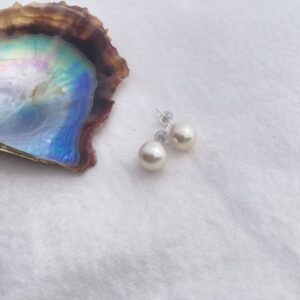
At Flower Jem, I have named these pearls the Sixty Series. If you would like to learn more about the history behind the Sixty Series, please visit here:
Akoya Pearls with a Century of History – The Sixty Collection Bracelet
In this time, I am introducing a pair of 9mm stud earrings from this series. These pearls were harvested at least 60 years ago, yet they remain in remarkably good condition. In the past, pearl cultivation was said to last not just one or two years, as it does today, but three to four years or even longer. Because of this, the nacre layers became thicker and more durable.
The pearls in this pair measure 9.0 mm and 9.2 mm. Although they are old, their surfaces are impressively smooth. While not mirror-like, their luster is strong, placing them among the higher-quality pearls. On the back of one pearl, where the stud is attached, there are fine wrinkle-like wounds. In addition, there are about two small dot-shaped raised wounds, but beyond that, no other noticeable flaws can be seen.
These earrings are valuable not only for their appearance but also for the deep history they carry. While Ise, the home of Mikimoto, is known as the birthplace of cultured pearls, if not for the devastating flood 100 years ago, Sukumo might also have become a true pearl capital. After losing his pearls to the flood, Mr. Tōdō made the unexpected discovery of the pearl stain removal method, which eventually drew pearl dealers from all over Japan to Kobe. Even today, Kobe remains full of pearl dealers.
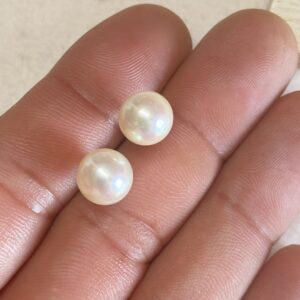
The explanation often given is that “the light reflected from Mt. Rokko is ideal for pearl sorting,” but when I first heard that, I thought, “Something doesn’t add up—something is being hidden.” After all, sunlight does not actually reflect off the mountain in that way.
The truth is that pearl dealers did not want to openly acknowledge stain removal processing. If people knew Kobe became a hub because of it, they would have to explain the process. But if they said the light of Mt. Rokko was perfect for pearl sorting, they could avoid the topic altogether. That was the reason.
Although I thought, “There’s no way mountains reflect sunlight like that,” tourists hearing the explanation often nodded in agreement, perhaps because it made pearl sorting feel like a special and mystical craft. When I asked my supervisor about it, he told me, “Don’t dig too deep into that.” Clearly, he too wanted to avoid talking about stain removal.
Because of this, Mr. Tōdō’s invention of stain removal has remained little known to the public.

In truth, almost all Akoya pearls (except natural blue and a few others) undergo stain removal. More than 80% of pearls on the market are also “toned,” which in strict terms means dyed. The term “toned” is used to avoid the word dyed, but when I asked processing specialists directly, they confirmed that both are essentially the same. Toned simply means lightly dyed.
Many jewelers prefer to describe pearls as “natural,” “untreated,” or “in their original state,” and so they avoid the word dyed. This tendency to avoid discussion of processing has naturally led to less mention of Mr. Tōdō’s groundbreaking technique.
Meanwhile, Mikimoto pearls are now an overwhelmingly dominant brand. Within that context, the fact that Sukumo was the first to succeed in round cultured pearls—even if only briefly—may be seen as an unnecessary detail to highlight.
There are pearl specialists who spend years uncovering and documenting these truths, sometimes publishing them in books, though others in the industry whisper, “Don’t stir up unnecessary things.” Some say, “Let it be. Mikimoto being recognized as the world’s first is good enough.” Personally, I believe Mikimoto’s dominance is unshakable regardless, and I respect that. Still, these historical truths should not be forgotten.
Stain removal is now indispensable for pearl dealers, but it also carries this shadowy side.
These earrings are crafted from pearls cultured over 60 years ago in Sukumo, the once-lost pearl capital. Despite being shaped by time, natural disasters, and human ambition, they have transcended the years and still shine brightly today.
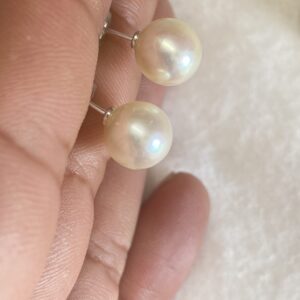
Towa means “eternity” in Japanese.
Here is the video that captures the making process of these earrings:
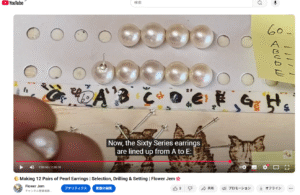
Around the 2:00:50 mark, you can see these earrings in progress.
The pearl pairs labeled A through E are the Sixty Series, and this particular pair, Towa, corresponds to pair C. Watching the video will also allow you to compare them with the other Sixty Series pieces. I invite you to take a look.
**********************************
The above is the product description for Towa listed on Etsy.
When I read the product description for Towa again, I realized that it feels less like a product listing and more like a historical essay about pearls.
I tried to rewrite it into something more like a typical product description, but I came to the conclusion that these pearls cannot exist without their history. They only make sense when that history is part of the story.
I first encountered the pearls of the Sixty Series around 2022.
At the time, I was working for a pearl company, but the head office was so quiet that I felt guilty receiving a salary.
While many workers at the pearl farm were rushing around caring for Akoya oysters from early morning or spending the entire day focused on nucleus insertion, the headquarters felt more like a coffee shop.
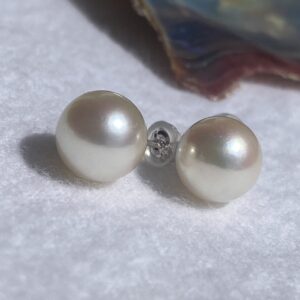
I had grown to love Akoya pearls. The people who nurture them in the scorching heat and freezing cold are those at the pearl farms.
Sitting in an air-conditioned office made me feel guilty toward them. Perhaps if the head office had been a more demanding workplace, I wouldn’t have felt that way.
This was not the only reason, but I eventually became mentally ill. After nearly a decade of effort at that company, I could no longer understand what it had all been for.
I also served as a liaison between the head office and the farm. People at headquarters would tell me, “Always prioritize the head office,” while those at the farm would say, “We’re the ones actually caring for the oysters.”
I tried to remain neutral, but I was once yelled at, “Whose side are you on — the farm’s or the head office’s?”
I replied, “I’m not thinking in terms of sides. I’m thinking about what’s best for the company as a whole.”
But they didn’t seem to understand. They continued dividing everything into “head office” and “farm.”
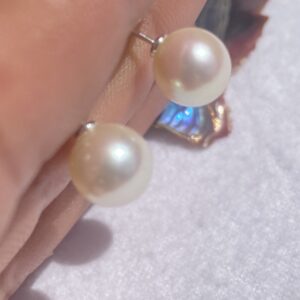
It’s a common story, I suppose.
But in such an environment, pursuing the right path felt meaningless. The only way not to feel that way was to do the job half-heartedly.
For about six months, I spent my days browsing apartment listings online at my desk.
“Nice room.” “Spacious and cheap, but too far.” “What kind of person lives in a place this expensive?” — that was how I passed the time.
But such days only worsened my mental state.
Despite all this, the company provided a great environment for someone who loved pearls.
I could handle pearls every day. Even though the job was mostly idle, during the busy harvest season I could spend two months straight sorting freshly harvested pearls.
I also gained experience across the entire process — from harvest to processing, wholesale, and retail.
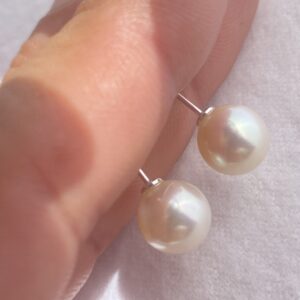
It was a wonderful environment in that sense, but the company’s culture was devoid of real value.
After more than a year of inner conflict, I spent the final two months carefully considering whether to resign while sorting harvested pearls.
When the sorting was done, and I had completed the cataloging work and listings for the auction, I called the head office from the farm and resigned.
Ah — I was supposed to talk about how I encountered the Sixty Series. Let me start over.
Around 2022, I fell ill and took a few months off work.
My doctor said, “It’s good to travel or change your environment. But you’re exhausted — like an engine running at full speed. Take things slowly.”
So I traveled by motorcycle — visiting the island where the pearl farm was located, or riding all the way to Tokyo over two days on regular roads.
During that time, I also attended small gatherings at a pearl dealer’s home with a few people from the industry.
That’s where I met Mr. Todo.
After attending a few times, I grew bored — the same topics came up repeatedly: the definitions of color treatment, pre-processing, stain removal, bleaching, and the order in which they’re done. They discussed such things for hours.
One day, a dealer I was close to said, “Jem, your home is nearby, right? Next time, why don’t we slip away with Mr. Todo?”
And so Mr. Todo began visiting my home.
I told him about my mental state, my leave from work, and how I was selling pearls personally on a site called Etsy.
He used to work in the jewelry business and now worked with pearls.
Knowing jewelry well, he told me, “Jem, you should try metalworking.”
Coming from a senior figure like him, I immediately bought metalworking tools online.
When he heard that, he was pleased and encouraged me.
During one of his visits, we talked about pearl prices. Due to COVID-19, prices had collapsed. “Now is the time to stock up,” he said. “History shows they’ll recover. When the pandemic ends, the economy will move again.”
I complained that my company was selling unsold pearls at auction for extremely low prices.
Then he said, “I have pearls that belonged to my great-grandfather. Would you like to buy them?”
That was how I encountered the pearls of the Sixty Series.
It wasn’t a dramatic story at all.
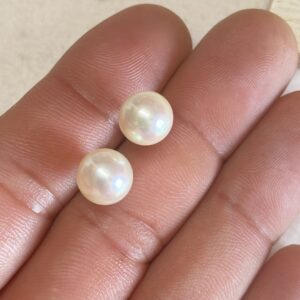
When I decided to buy them, I asked if I could mention his name on Etsy and note that his great-grandfather had been involved — possibly even a hundred years ago.
He replied, “You can mention my name, but there’s no proof they’re 100 years old. They’re definitely more than 60 years old — that’s safe to say.”
He now deals only in South Sea pearls and doesn’t know much about Akoya.
He also spoke little about his great-grandfather, Masai Todo — the man who invented stain-removal processing. He seemed reluctant to talk about such a historically significant figure.
I purchased the pearls around October 2022, just before the harvest season.
I then sent them for stain removal, but complications arose, and I didn’t see them again until August 2025.
At one point, I thought pearls born in a “phantom pearl sanctuary” would truly remain just that — a phantom.
But after several years, they finally became pearl jewelry.
I had almost forgotten — it was Mr. Todo who encouraged me to start metalworking.
Through him, I not only encountered the pearls that would become the Sixty Series but also found the spark to start a new craft.
It was also during those days, while feeling frustrated with my company, that someone first suggested I try selling pearls on Etsy — after I brought pearls to a customer on my day off.
Every pearl I handle carries memories.
And the Sixty Series carries not just the historical weight of Sukumo — the “phantom sanctuary” — but also my personal memories of a difficult time and how I began to overcome it.
“When things feel heavy,”
sometimes a change of environment, people, or atmosphere can be the beginning of something new.
